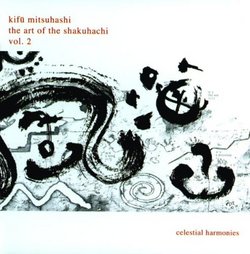| All Artists: Kifu Mitsuhashi Title: The Art of the Shakuhachi, Volume Two Members Wishing: 2 Total Copies: 0 Label: Celestial Harmonies Release Date: 4/1/2003 Genres: International Music, Pop Style: Far East & Asia Number of Discs: 1 SwapaCD Credits: 1 UPC: 013711322521 |
Search - Kifu Mitsuhashi :: The Art of the Shakuhachi, Volume Two
 | Kifu Mitsuhashi The Art of the Shakuhachi, Volume Two Genres: International Music, Pop
This recording is the second in Celestial Harmonies' series The Art of the Shakuhachi, documenting the art of the shakuhachi, performed by one of Japan's foremost performers, Kifu Mitsuhashi. The shakuhachi is a bamboo ... more » |
Larger Image |
CD Details
Synopsis
Album Description
This recording is the second in Celestial Harmonies' series The Art of the Shakuhachi, documenting the art of the shakuhachi, performed by one of Japan's foremost performers, Kifu Mitsuhashi. The shakuhachi is a bamboo end-blown flute with four finger holes in the front and one in the back. Although it is a very unpretentious instrument, a skilled player can produce an astounding number of pitches and a nearly infinite variety of timbres and shadings.The sounds heard in the most traditional shakuhachi music (honkyoku, literally `basic' or `original') are usually not so much melodies in the Western sense of the word as they are a carefully composed series of short motives, phrases, and pitch cells played in a highly flexible rhythm and sometimes separated by long rests. Many varieties of grace notes, portamenti, pitch blending, explosive bursts of air, flutter tonguing, finger tremolos, vibrato and much else charge each pitch or phrase with great intensity and musical meaning. Although the pieces recorded on this CD are all of solo shakuhachi music, the instrument is also frequently featured in ensembles.The oldest known ancestor of the shakuhachi is the gagaku (court music) shakuhachi imported to Japan from China or Korea. These somewhat slender instruments, made either from bamboo or from jade, stone, or ivory, are in three sections. They have six finger holes and were apparently used in court ensemble music. The exact nature of the music played on these instruments remains unclear; after the 10th century the shakuhachi was rarely used in the gagaku ensemble.Several major "schools" or styles of traditional shakuhachi playing exist in Japan, each maintaining its own repertory, much of which, however, is shared with other "schools" as well. One of the largest and best known schools, of which Kifu Mitsuhashi is an exponent, was founded in Edo (today Tokyo) by Kinko Kurosawa (1710-1771).Music for the shakuhachi performed by Kinko-school players today centers on the "basic pieces" (honkyoku) which often trace their roots to the music of the shakuhachi-playing Zen monks of the Edo or Tokugawa period (1603-1868).Today, the shakuhachiis perhaps the most international of all Japanese instruments. Its repertory includes folk song, jazz, and contemporary art music of many styles. The pieces included on this CD, however, are all anchored in the traditional shakuhachi music of the Edo period. It includes Ajikan, one of the most famous in the entire shakuhachi repertory which is played by nearly everyone who performs traditional honkyoku. The title refers to an important meditative practice of Shingon-sect esoteric Buddhism.Booklet annotation and translation is provided by Associate Professor Gerald Groemer of Yamanashi University, Kofu, Japan, based in part on material provided by Kayu Kanda.

 Track Listings (7) - Disc #1
Track Listings (7) - Disc #1